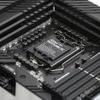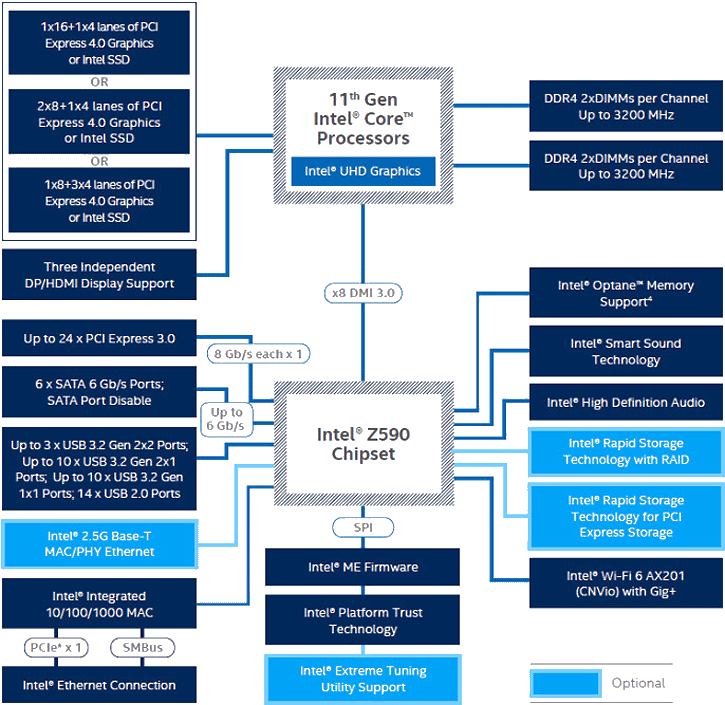11th Gen Core series processors and Z590
11th Generation Core series processors (RKL)
Intel has been unfolding the new series with an up-to 8-core and thus 16-threads processor (2 cores down from last-gen) in the desktop processor segment (HEDT seems dead). Intel markets this series as its Core processor series whereas HEDT would have been tagged Core-X. More recently it has been adding the denominator the Core i9 series into that desktop lineup. Rocket Lake-S-based processors need to be paired with the Z490 series chipset (after compatible BIOS upgrade) or the new Z590 chipset for motherboards, as it has processor socket LGA1200. The top of the line processor is the Core i9-11900K with 8 cores and 16 processing threads (SMT). Its Base / Turbo frequency is 3.5 GHz and it can run upwards to 5.3 GHz on a core or two with what is called a velocity boost. It has 16 MB of L3 cache (down from 20MB), 20 PCI-Express 4.0 lines on the CPU, DDR4 @ 3200 MHz Dual-Channel memory configuration support, and a 125W TDP.
- TB2 - Intel Turbo Boost Technology 2.0: Dynamically increases the processor frequency up to 4.9 GHz when applications demand more performance. Speed when you need it, energy efficiency when you don’t.
- TB3 - Intel Turbo Boost Max Technology 3.0: Identifies the four best-performing cores to provide increased single- and dual-core performance up to 5.2 GHz, quad-core performance up to 5.1 GHz.
- Velocity Boost
- Adaptive Boost
Velocity Boost
Intel offers a third classification for its highest boosting frequency, this is called 'Thermal Velocity Boost'. This is an extra boost of 100 MHz, on both the single and all-core turbo, however, it is only active under certain conditions. The conditions, as you can tell by its name, are the temperature of the processor, which needs to remain below 70 degrees Celsius. Once the processor gets warmer than this value, you'd revert to base or lower frequencies. This technology was introduced with Cascade Lake-X and is available towards mainstream desktop to ensure single-threaded tasks run on the fastest cores. Pretty much end-users with liquid cooling will benefit from this the most.
Adaptive Boost
Two weeks prior to release, another boost mode got introduced, which has been finding its way into BIOSes one week prior to reviews. The 11th Gen Core series codenamed “Rocket Lake-S” will get a 4th Boost mode, labeled Adaptive Boost. Both Thermal Velocity Boost (TVB) and Adaptive Boost Technology (ABT) will be exclusive to Rocket Lake’s Core i9-11900K(F) series. Adaptive Boost will only be available for the Core i9 K and -KF models: In other words, only Core i9-11900K and Core i9-11900KF. With a processor temperature of less than 70°C, it achieves a Thermal Velocity Boost of 5.3 GHz on two cores. That's 5.2 GHz without TVB. If more than two cores are working, a maximum of 5.1 GHz is possible, but only for up to four cores if TVB activates. So four cores max. Adaptive Boost now takes it up a notch, if a proper power supply is applied, and if temps remain below 70 Degrees C, all eight cores can boost to 5.1 GHz. So for more than four cores the up to 5.1 GHz far exceeds the previous specification of 4.9 or 4.8 GHz. You'll need the latest BIOS revisions to get this supported. You can see where this new Boost feature would help, multi-threaded apps and games.
The official recommendation for system memory is now DDR4-3200, far below what the CPUs can actually manage. What is new, however, is the so-called Gear 1 or Gear 2 mode, which you can compare with the synchronous IF (Infinity Fabric) clock at AMD. Only the top model Core i9-11900K guarantees DDR4-3200 with Gear 1, all other CPUs have to make do with Gear 2 and can only use Gear 1 up to a maximum of DDR4-2933. According to Intel, Gear 2 costs a bit of performance and latency, we will definitely investigate this more closely as soon as the time comes, because so far Intel has been silent on this topic. All CPUs have up to 44 PCI-Express 4.0 lanes. The Thermal Velocity Boost only works up to 70 ° C. Only the K models have an open multiplier for overclocking. Only the Core i9 models have the official Gear 1 approval for the RAM with DDR4-3200, DDR4-2933, however, works with every CPU with Gear 1.
Xe Integrated graphics
Intel also used the Xe graphics from 10nm Tiger Lake and re-purposed these towards 14nm, Xegraphics. The processors have Xe-LP GPU cores, holding 32 EUs, which should be significantly slower than the 24 older EUs on Comet Lake. While making use of the new Xe generation, the cores have proved to be up to 40% slower than what the completion offers. Some key features:
- Support for AVX-512 baked into Intel desktop CPUs.
- Integration of Intel’s new Xe-LP graphics core
- Support for up to 20 PCIe 4.0 lanes
- DDR4-3200 support
TDP and PL States
Rocket Lake processors are allowed to run load clock frequency values considerably higher and longer than 9th and 10th gen Coffee Lake. The TDP that is specified/listed is 125 Watt for the more core parts with 65 Watts for the more energy-friendly models. However, the story does not end there though as these TDP values are based on what is called the P1 state. For a 9900K that value sits at 95W, with the Comet- and Rocket Lake S thus 125W, of course, it is two more cores so nobody will wonder about that. However, there is also a PL2 state where a higher power limit can be applied for a short time. If you allow me to take that 9900K again as an example, it had a PL2 allowance of 1.25 times PL1, = 119W, for a duration of 28 seconds. Here's what's so different and where Intel yields most of its performance for Comet and Rocket lake, if I take the 11900K as an example, PL2 now is 2 times PL1, so 250W. That PL2 state now also is more longspun, ~56 seconds. And therein reaps the benefit of additional performance, substantially, but at the cost of energy and heat.
| CPU | P1 State | PL2 State | Duration |
|---|---|---|---|
| Core i9 11900K | 125 Watt | 250 Watt | 56 seconds |
| Core i7 11700K | 125 Watt | 229 Watt | 56 seconds |
| Core i5 11600K | 125 Watt | 182 Watt | 56 seconds |
| Core i9 9900K | 95 Watt | 118 Watt | 28 seconds |
| Core i9-9900KS | 127 Watt | 159 Watt | 28 seconds |
This means the overall performance can be a lot higher, but it will have an effect on power consumption and inevitably, heat levels. That close to a minute PL2 state duration is significant. With such significant power states, we do fail to see the significance and reliability of a listed TDP value these days if you allow double the TDP for almost a minute these days. Motherboard manufacturers can and will play around with this value, with maybe even longer PL2 states.
Z590 and PCI Express 4.0 support
With each new generation of CPUs, new chipsets are introduced at Intel. With Bo (a) rd this time are B560, H570, and Z590. The biggest innovation concerns the B560 and H570 chipsets, which for the first time offer the possibility of overclocking the main memory, which was previously reserved for the Z chipsets. According to Intel, the individual board manufacturers decide how much RAM-OC the boards can handle. There is also support for USB 3.2 Gen 2, x8 DMI Gen 3.0, Wi-Fi 6E, and Thunderbolt 4. Rocket Lake-S will move towards PCI Express 4.0, however just the processor. The Z590 PCH is still fully fetched PCIe Gen 3.0, the PCIe Gen 4.0 graphics card lanes thus are driver straight from the processor, and not chipset. The DMI link as such also sticks towards PCIe Gen 3.0 lanes (DMI = interconnect in-between CPU and chipset). Intel however did double up the bandwidth, connecting not four but eight lanes (with Z590). That also means Z490 is still using an x4 DMI PCIe Gen 3 interlink. And in case if you ever wondered how much one Z590 chip costs, it is 50 USD.
OC Features
Intel provides more features than Comet Lake. In addition to the mentioned memory OC options on B560 and H570 chipsets, you have the option of changing the memory clock in real-time, configuring the offset for AVX2 and AVX-512 individually or even switching off AVX completely. Rocket Lake offers all the advantages that Comet Lake already offered, including XM profiles for the RAM, the Velocity Boost, per-core hyperthreading, BCKL-OC, maximum clock rate for individual cores - there are no limits to the possibilities, it should go without saying that you need a K-suffixed CPU to do this.



